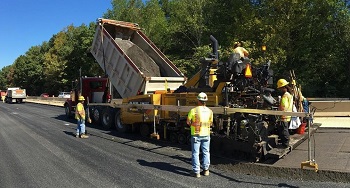VDOT Uses CCPRM On I-64
Print this Article | Send to Colleague
Photos & Article Contributed By Marshall Luck, Allan Myers
In 2011, VDOT took the bold step to combine three different pavement recycling techniques on one project – full-depth reclamation (FDR), cold in-place recycling (CIR) and cold central plant recycling (CCPR). Since then, VDOT has sponsored test sections on the NCAT Test Track, and others have done work to expand upon that knowledge and experience. To date, research and field performance has shown excellent promise in these sustainable materials and techniques. As such, VDOT has allowed cold central plant recycled material (CCPRM) and full-depth reclamation to be used on several high-profile projects, including Phases II and III of the I-64 reconstruction and widening.
Phase II and Phase III of I-64 is between Williamsburg and Hampton. This area of the state, like other urban areas, has an abundance of recycled asphalt pavement (RAP). In Virginia alone, there is an estimated 15 million tons of RAP sitting on contractor yards and elsewhere. While sitting on the ground, RAP may have little value, but as part of new asphalt mixes and CCPRM, it represents a tremendous cost savings.
 Phase II, awarded to Allan Myers, is scheduled to be completed in the spring of 2019. Phase III, awarded to Shirley Contracting with the paving performed by Allan Myers, has a planned completion date of 2021. To produce the CCPRM, Myers acquired a Wirtgen mobile cold mix plant known as the KMA 220. CCRPM can be made with 100 percent RAP or a combination of RAP and virgin aggregate. The plant itself takes up a much smaller footprint than a conventional asphalt plant. There is no specialized equipment needed to place the product. The use of CCPRM not only represents huge energy and raw material costs savings but has a positive impact on the environment as well.
Phase II, awarded to Allan Myers, is scheduled to be completed in the spring of 2019. Phase III, awarded to Shirley Contracting with the paving performed by Allan Myers, has a planned completion date of 2021. To produce the CCPRM, Myers acquired a Wirtgen mobile cold mix plant known as the KMA 220. CCRPM can be made with 100 percent RAP or a combination of RAP and virgin aggregate. The plant itself takes up a much smaller footprint than a conventional asphalt plant. There is no specialized equipment needed to place the product. The use of CCPRM not only represents huge energy and raw material costs savings but has a positive impact on the environment as well. CCPRM and FDR are the foundation materials for the I-64 projects. On the Phase II paving section, the project utilizes either 12 inches of full-depth reclamation (FDR) or 12 inches of cement-treated base (CTB). The CTB was produced from recycled concrete. On top of the FDR or CTB was placed 2 inches of an asphalt-stabilized open-graded drainage layer (OGDL), 6 inches of CCPRM, 2 inches of SMA 19.0 (PG 64E-22) and 2 inches of SMA 12.5 (PG 64E-22). Approximately 180,000 tons of CCPRM will be placed by the end of the project. The Phase III project will also incorporate similar quantities of CCPRM when completed.
While extremely sustainable, the use of CCPRM and FDR are providing a huge cost savings to VDOT and the traveling public. Rough calculations put the savings at $15 million for the two phases. This savings provides funds that can be utilized on other projects that will help "Keep Virginia Moving."
